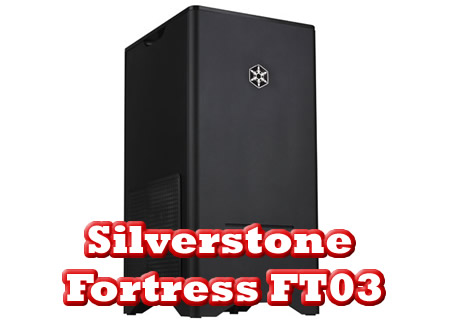Silverstone Fortress FT03 Review
Introduction
Silverstone have had their Fortress series out for some time now, yet this is the first time one has graced the pages of OC3D. Thankfully though it’s not the first time we have seen a Silverstone chassis that utilises one of, if not the, very basic law of thermodynamics: heat rises. SO when designing this range of cases Silverstone decided to incorporate this very basic characteristic and have the cool air coming in the bottom and the warm air straight out the top. This did how ever bring with it some design issues, most noticeably the fact all the cables are now at the top rather than at the back of the case!
The design for the FT03 was somewhat more complicated however. Silverstone decided they wanted to make a case with a much smaller footprint and build upwards, rather than back like they had with other chassis which were noticeably deeper than a normal case. Building upwards required some serious open minded designs and that’s what we are here to look at today. Is this a step too far, or are Silverstone on to a radical winner?
To get a better idea of whats Silverstone’s goals are for all their products let’s take a look at a snippet from the philosophy section on their website:
SilverStone Technology’s philosophy is based on our recognition that merely having innovative expertise within the industry is not enough. Our objective is to ensure that our expertise is delivered to all products with consistency, in response to user’s needs, and with maximum user satisfaction. SilverStone Technology thrives on challenges of rapid technological advancements and creating aesthetic standard for the industry.
Some very big claims there, but rather than dissecting the exact meaning of it let’s just move swiftly on to the specifications before we make the tea and biscuits and get comfy for the video.Â
Specifications
|
Model No. |
SST-FT03B (black) | |
| SST-FT03S (silver) | ||
| — | ||
| — | ||
|
 Material |
Aluminum outer shell, steel body | |
|
 Motherboard |
Micro ATX, Mini-DTX, Mini-ITX | |
|
 Multimedia |
— | |
|
 Drive Bay |
 External | Slot loading slim optical drive x 1 |
| — | ||
| Â Internal | 3.5″ x 3 * , 2.5″ x1 | |
|
 Cooling System |
 Front | — |
| Â Rear | — | |
| Â Side | — | |
| Â Top | 1 x 120mm exhaust fan, 1200rpm, 22dBA 1 x 92/80mm optional fan |
|
| Â Bottom | 2 x 120mm intake fans, 1200rpm 22dBA 2 x 80mm optional fan slots |
|
| Â Internal | — | |
| Â Hard Drive | Aluminum side panel heat conduction | |
|
 Expansion Slot |
 4 |
|
|
 Front I/O Port |
USB 3.0 x 2 (backwards compatible with USB 2.0) audio x 1 MIC x 1 |
|
|
 Power Supply |
Standard PS2 (ATX) | |
|
 Operating system support |
— | |
|
 Expansion Card |
Compatible up to 13.77†long | |
|
 Limitation of CPU cooler |
167mm | |
|
 Limitation of PSU |
up to 180mm deep | |
|
 Net Weight |
6.7kg | |
|
 Dimension |
235mm(W)x487mm(H)x284mm(D) | |
Â
Video Review
Conclusion
I’ve been sat here for about an hour now trying to work out how to start this conclusion. I wanted to cram so much in I just could work out how to get it going. The fact of the matter is this case could have gone so very very wrong by being overcomplicated. Its definitely never going to win any awards for simplicity but any one actually able to match the right blocks for the cut out shapes on childs toys should just about be able to build a decent and tidy rig in this case.
CPU heatsink and GPU’s do need to be thought about carefully but, at very worst, you do have the option to remove the case fans. It’s worth noting something I missed in the video that if you do remove the fan for the GPU area you can still fit 2x 80mm fans in the floor to help provide airflow.
Something people have been worried about was hard drive temperatures because there is no active cooling. I’ve never really had any hard drive heat issues with what I’ll call a normal drive though, unless you are running something that’s notoriously a bit warmer like the WD Velociraptors I really don’t foresee any heat related problems in this area.
With its small foot print and sleek exterior design I really can see this chassis being very popular with some one short on space or looking to build a slightly more powerful HTPC/cross over gaming system for their front room. I can also see this being a very popular case for people low on space where the case is built upwards from a small footprint. Managing this and keeping everything inside and outside in check definitely deserves some Brownie points.
The internal design is very well thought out and is much better to use in reality than I first thought. Silverstone definitely deserves the OC3D Innovation award for the design of the chassis and a Silver Award for the case as a whole.
Thanks to Silverstone for the FT03 tested today, you can discuss this and many other topics in the OC3D Forums.





